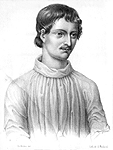
 |
| Giordano Bruno |
Giordano Bruno (1548-1600)
Filippo Bruno was born in Nola, near Naples, the son of Giovanni Bruno, a soldier, and Fraulissa Savolino. He took the name Giordano upon entering the Dominican order. In the great Dominican monastery in Naples (where Thomas Aquinas had taught), Bruno was instructed in Aristotelian philosophy. His exceptional expertise in the art of memory brought him to the attention of patrons, and he was brought to Rome to demonstrate his abilities to the Pope. During this period he may also have come under the influence of Giovanni Battista Della Porta, a Neapolitan polymath who published an important book on natural magic. Bruno was attracted to new streams of thought, among which were the works of Plato and Hermes Trismegistus, both resurrected in Florence by Marsilio Ficino in the late fifteenth century. Hermes Trismegistus was thought to be a gentile prophet who was a contemporary of Moses. The works attributed to him in fact date from the turn of the Christian era.
Because of his heterodox tendencies, Bruno came to the attention of the Inquisition in Naples and in 1576 he left the city to escape prosecution. When the same happened in Rome, he fled again, this time abandoning his Dominican habit. For the next seven years he lived in France, lecturing on various subjects and attracting the attention of powerful patrons. From 1583 to 1585 he lived at the house of the French ambassador in London. During this period he published the books that are most important for our purposes, Cena de le Ceneri ("The Ash Wednesday Supper") and De l'Infinito, Universo e Mondi ("On the Infinite Universe and Worlds"), both published in 1584. In Cena de le Ceneri, Bruno defended the heliocentric theory of Copernicus . It appears that he did not understand astronomy very well, for his theory is confused on several points. In De l'Infinito , Universo e Mondi, he argued that the universe was infinite, that it contained an infinite number of worlds, and that these are all inhabited by intelligent beings.
Wherever he went, Bruno's passionate utterings led to opposition. During his English period he outraged the Oxford faculty in a lecture at the university; upon his return to France, in 1585, he got into a violent quarrel about a scientific instrument. He fled Paris for Germany in 1586, where he lived in Wittenberg, Prague, Helmstedt, and Frankfurt. As he had in France and England, he lived off the munificence of patrons, whom after some time he invariably outraged. In 1591 he accepted an invitation to live in Venice. Here he was arrested by the Inquisition and tried. After he had recanted, Bruno was sent to Rome, in 1592, for another trial. For eight years he was kept imprisoned and interrogated periodically. When, in the end, he refused to recant, he was declared a heretic and burned at the stake.
It is often maintained that Bruno was executed because of his Copernicanism and his belief in the infinity of inhabited worlds. In fact, we do not know the exact grounds on which he was declared a heretic because his file is missing from the records. Scientists such as Galileo and Johannes Kepler were not sympathetic to Bruno in their writings.
Sources: A convenient introduction to Bruno is the article by Frances Yates in the Dictionary of Scientific Biography. Several of Bruno's works have been translated into English. See The Ash Wednesday Supper, tr. Stanley L. Jaki (The Hague: Mouton, 1975); Sidney Greenberg, The Infinite in Giordano Bruno, with a Translation of his Dialogue Concerning the Cause, Principle, and One (New York: King's Crown Press, 1950); Jack Lindsay, Cause, Principle, and Unity; Five Dialogues (New York: International Publishers, 1964); Dorothea Waley Singer Giordano Bruno, his Life and Thought. With Annotated Translation of his Work, On the Infinite Universe and Worlds (New York: Schuman). The crucial work on Bruno's thought is Frances Yates, Giordano Bruno and the Hermetic Tradition (Chicago: University of Chicago Press, 1964). See also Walter Pagel, "Giordano Bruno: The Philosophy of Circles and the Circular Movement of the Blood," Journal of the History of Medicine and Allied Sciences 6 (1951)): 116-125; Angus Armitage, "The Cosmology of Giordano Bruno, Annals of Science 6 (1948):24-31.
Image: Christian Bartholméss, Jordano Bruno (Paris: Libaririe Philosophique de Ladrange, 1846), frontispiece.
Last updated
Science | Christianity | Library | About | Site Map | Search
Please note: We will not answer copyright requests.
See the copyright page for more
information.










